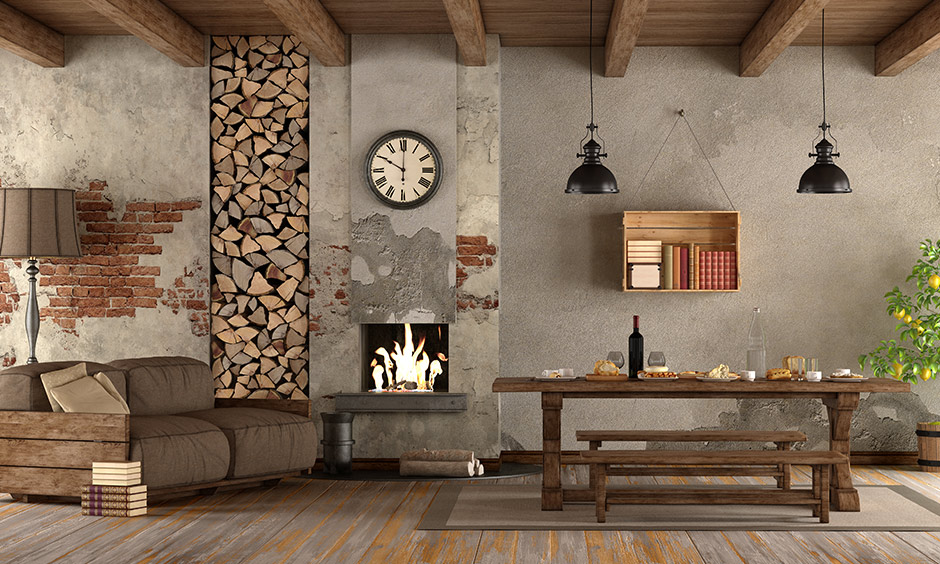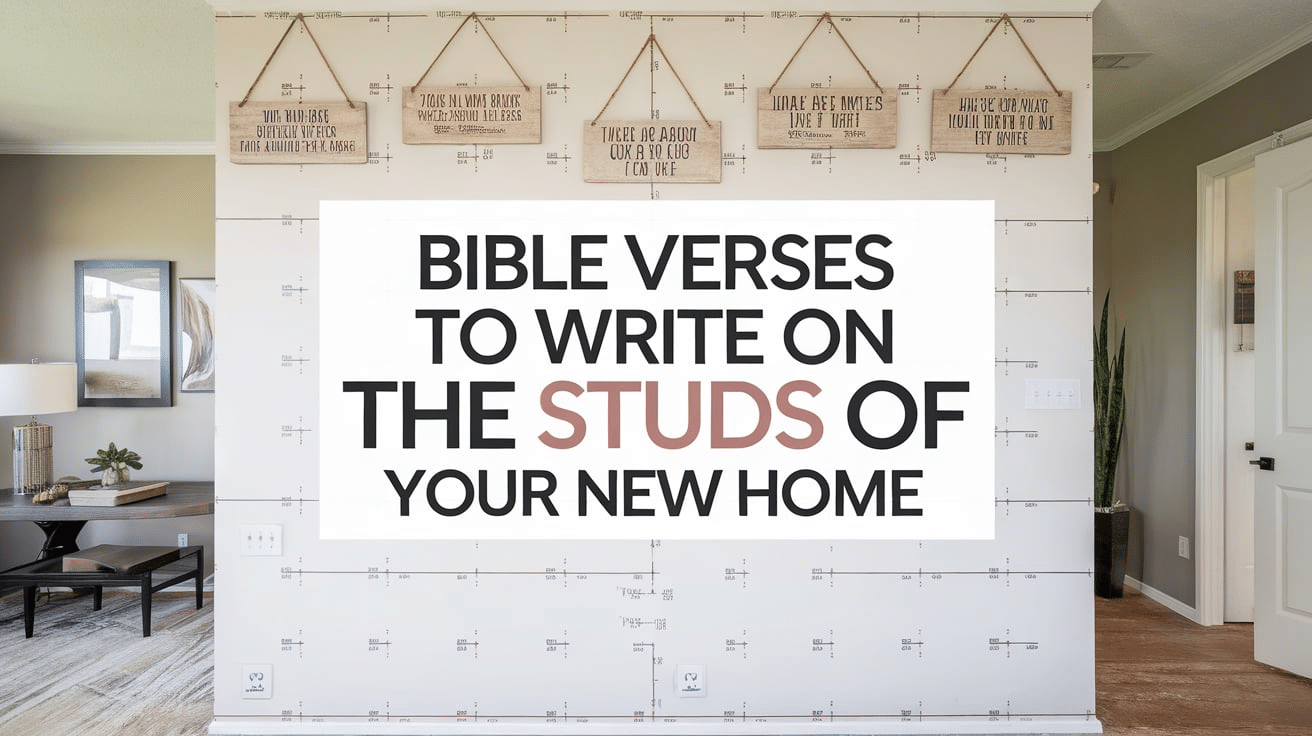15 Creative Ghost Painting Ideas to Inspire You
Standing in my studio last night, watching moonlight transform ordinary shadows into dancing spirits, I remembered why ghost painting captivates many artists.
Twenty years ago, my first spectral creation taught me that painting ghosts isn’t just about white forms on dark backgrounds – it’s about capturing the space between seen and unseen.
Each ghost painting tells stories that hover between reality and imagination.
Through carefully crafted techniques and thoughtful composition, we invite viewers to explore that magical threshold where the ordinary world meets the extraordinary.
Whether you’re a seasoned artist or picking up a brush for the first time, these 15 ghost painting techniques will guide you through creating your supernatural masterpieces.
Let’s explore how simple paint can give form to the formless.
List of Ghost Painting Ideas to Try
1. Luminous Spirit Creation
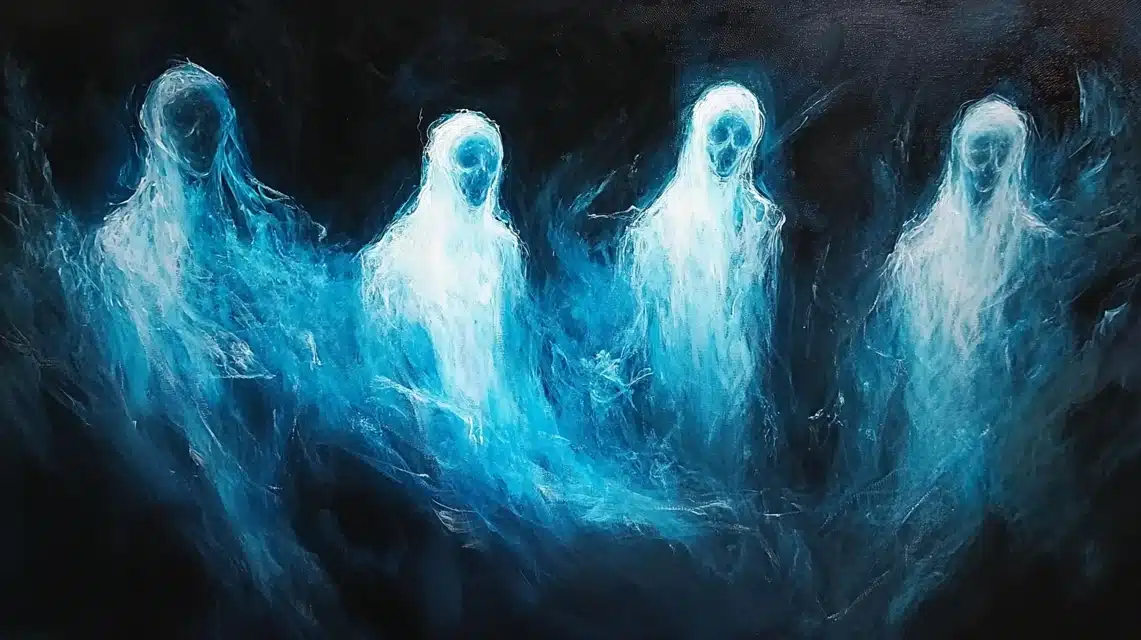
Unlike traditional ghost paintings, glow-in-the-dark spirits come alive when the lights dim.
Yesterday’s project proved how different phosphorescent paints create varying effects throughout the evening.
The real magic happens in layering – watch how multiple translucent coats build depth that only reveals itself in darkness.
Morning light shows subtle white figures, but evening transforms them into glowing apparitions.
Consider how different colored bases affect the final glow. Blue undertones create cool, ethereal spirits, while warm bases suggest friendlier phantoms.
Complete Painting Process:
- Prepare a dark canvas with a deep blue or black base, creating the perfect backdrop for ghostly appearances.
- Create detailed sketches using a light pencil to mark ghost positions and movement patterns throughout your scene.
- Layer phosphorescent paint carefully, building transparency through multiple thin applications rather than thick coverage.
- Add final highlights using pure white for daytime visibility while maintaining the nighttime glow effect.
- Seal carefully with a UV-protective clear coat, ensuring long-lasting luminescence.
2. Watercolor Whispers

Soft edges define ghostly forms as watercolors blend seamlessly into misty apparitions.
Each brush stroke requires perfect timing – too wet creates puddles, while too dry loses that ethereal quality.
Morning light reveals how various paper textures affect final appearances. Rough surfaces create textured spirits, while smooth hot-press paper allows perfect transparency.
Watch how colors blend at the edges, creating natural auras around each figure. Strategic water control builds depth through layered washes.
Complete Painting Process:
- Start by stretching high-quality watercolor paper, ensuring proper surface tension for controlled washes.
- Build a background atmosphere using graduated washes, establishing mood and depth for your ghostly figures.
- Layer transparent whites and pale colors, building ghost forms through careful lifting techniques.
- Create shadows and highlights using negative painting around spirit edges.
- Apply final details with slightly tinted white paint, suggesting ethereal movement.
3. Haunted Forest Apparitions
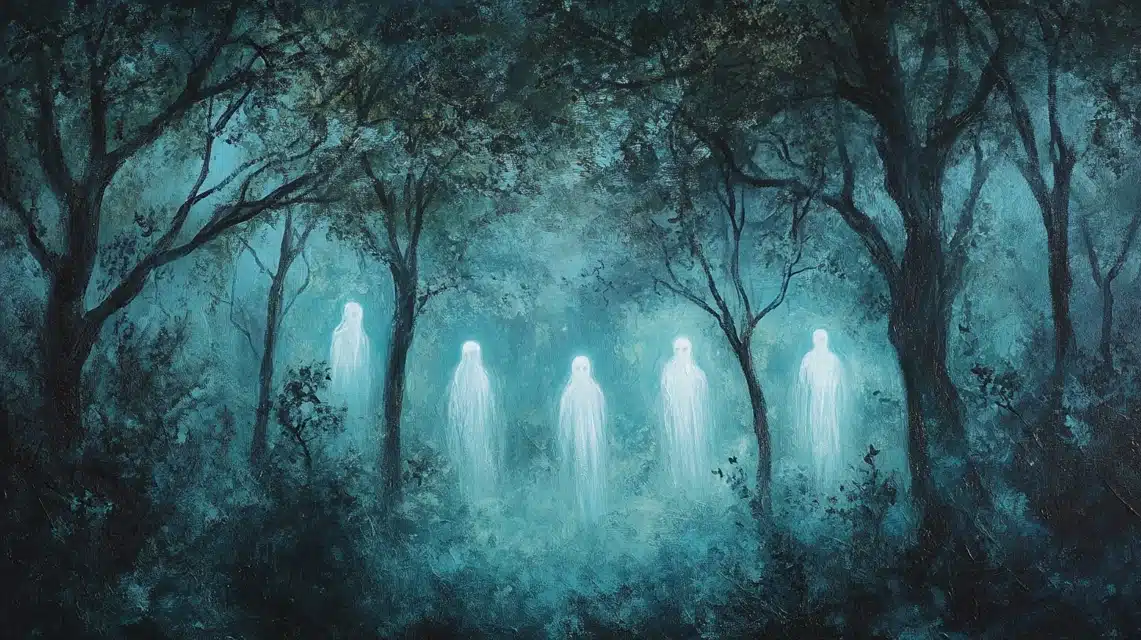
Deep shadows between twisted trees create perfect hiding spots for ethereal visitors.
Unlike typical forest scenes, this technique demands a careful balance between darkness and ghostly light.
Watch how morning mist effects develop through layered glazes – each coat building atmosphere while preserving luminous spirit forms.
Strategic branches frame supernatural elements, leading eyes through your composition.
Consider how moonlight affects different areas of your forest.
Silvery highlights on branches contrast with deep shadows where spirits lurk, creating dramatic depth.
Complete Painting Process:
- Establish a dark forest foundation using deep greens and blues, building layers for rich atmospheric depth.
- Create tree structures through careful negative painting, preserving light areas for future ghost placement.
- Layer translucent white spirits using dry brush techniques over a semi-wet background for soft edges.
- Build ethereal movement through directional brushstrokes, suggesting spectral motion.
- Add final highlights using pure titanium white mixed with pearlescent medium for the supernatural glow.
4. Vintage Specter Style
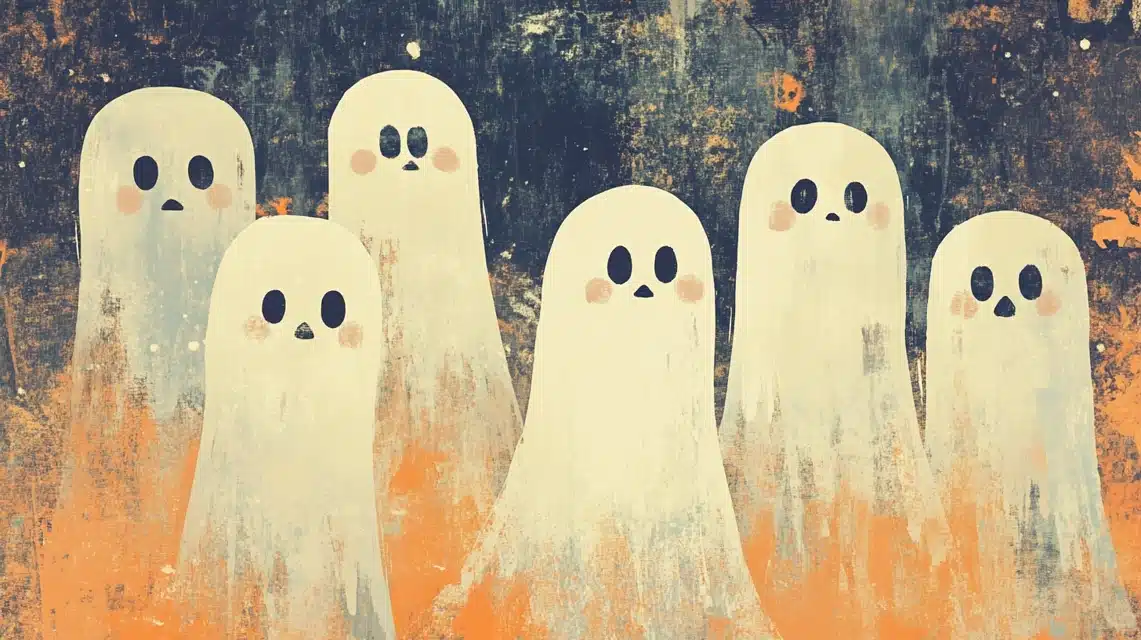
Capturing that perfect 1950s Halloween card charm requires understanding historical color palettes.
Yesterday’s attempt proved how subtle color shifts transform modern ghosts into nostalgic apparitions.
Each ghost tells its own story through exaggerated expressions and classic poses.
Watch how limited color palettes enhance vintage appeal – think muted oranges, warm greys, and creamy whites.
Strategic aging effects – slight color fading, paper texture, and carefully planned “wear” – build authentic vintage character.
Complete Painting Process:
- Begin with the aged paper effect using coffee staining or a light watercolor wash, creating the period-appropriate base.
- Sketch classic ghost shapes emphasizing rounded forms and expressive features common in vintage illustrations.
- Apply flat color areas using a period-appropriate palette mixed with slightly muted tones.
- Create worn effects through strategic erasing and subtle texture application.
- Build final details using careful line work emphasizing classic cartoon style.
5. Misty Cemetery Scene
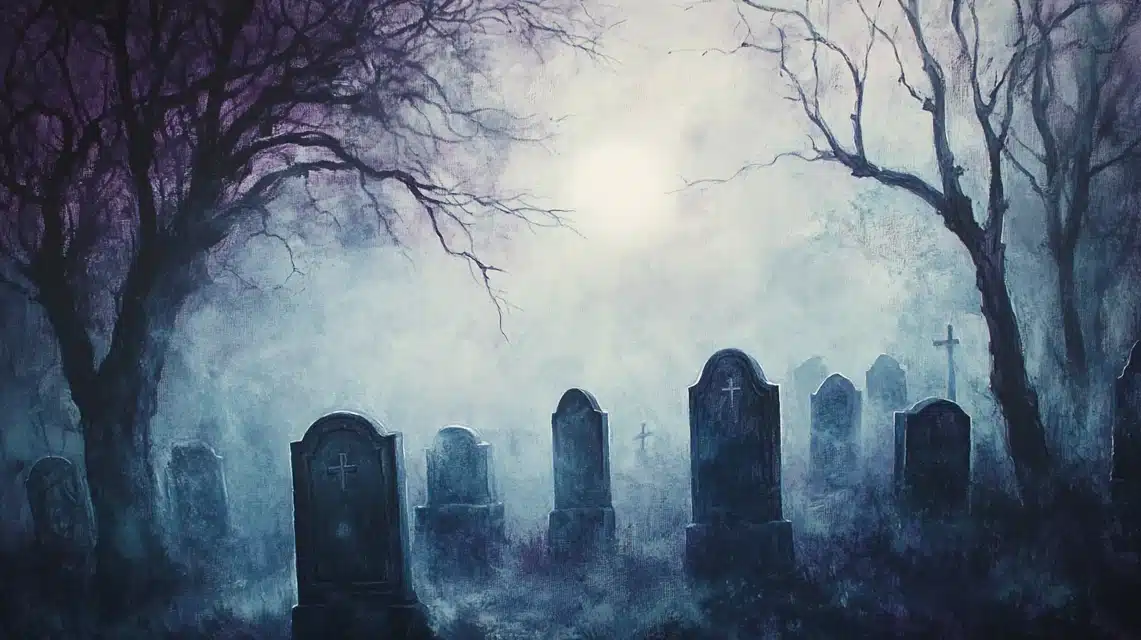
Unlike traditional landscape paintings, cemetery scenes with spirits demand perfect atmospheric control.
Morning fog effects require patient layering – each wash builds depth while maintaining ghostly transparency.
Watch tombstone shapes emerge through careful lifting techniques while spirits float through carefully crafted mist.
Strategic value control ensures your ghosts stand out without breaking atmospheric unity.
Consider how different times of night affect your scene. Early evening brings blue shadows, while midnight suggests deeper purples and blacks.
Complete Painting Process:
- Create a misty foundation using multiple light washes, building atmospheric depth gradually.
- Develop tombstone forms through negative painting and careful edge control.
- Layer ghost figures using white paint and a glazing medium for transparent effects.
- Build depth through strategic darkening of background elements while preserving foreground luminosity.
- Add final touches with a subtle iridescent medium, creating ethereal light effects.
6. Victorian Mansion Mysteries
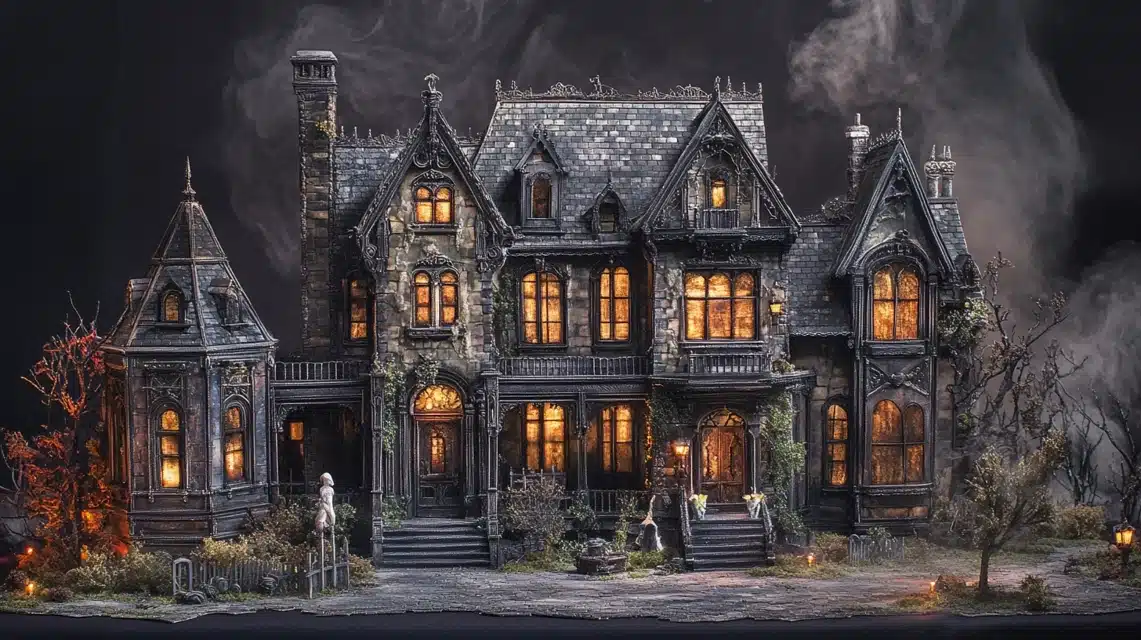
Behind each window pane, wispy figures dance their eternal waltz.
Through ornate moldings and towering turrets, ghostly inhabitants peek and play. The mansion itself becomes a character, its weathered facade holding centuries of stories waiting to materialize.
Last night’s painting session revealed how candlelight from within transforms simple window shapes into portals of possibility. Each shutter holds the potential for a spectral surprise, while gabled peaks pierce moody skies above.
Shadows lengthen as evening falls, and that’s when our painted phantoms truly come alive.
Complete Painting Process:
- Build an architectural foundation with precise perspective, establishing a grand Victorian presence.
- Layer warm interior glows, suggesting ghostly activities behind windows.
- Create ethereal residents using varied transparency levels and subtle movements.
- We are developing weathered textures to enhance the historical atmosphere.
- Add final luminous touches, bringing spirits to life.
7. Spectral Family Portrait
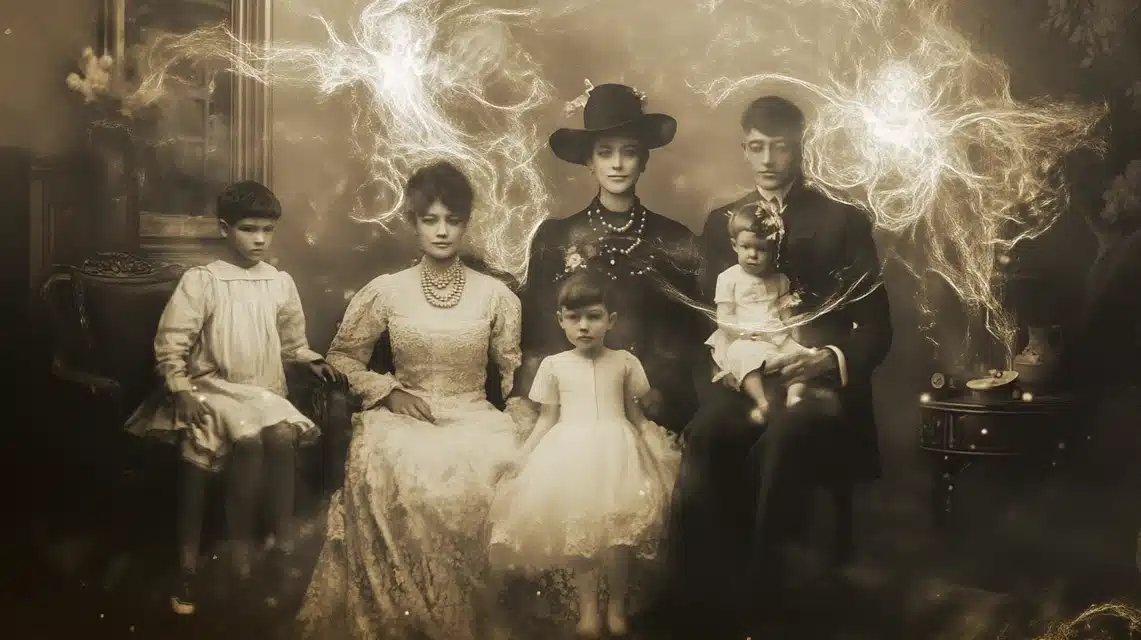
They gather for their yearly painting – Mother Ghost’s pearls floating perfectly askew, while Baby Ghost tumbles playfully through Father Ghost’s top hat.
Time stands still in this ethereal family scene, frozen in supernatural domesticity. Small details tell big stories – a translucent teatime, an otherworldly game of fetch with a phantom dog.
Each spirit’s personality shines through carefully crafted expressions and poses, creating characters that viewers can’t help but love.
Complete Painting Process:
- Design formal composition following traditional portrait structures with ghostly twists.
- Develop individual character expressions through detailed preliminary sketches.
- Build ethereal forms using layered translucent whites and subtle colors.
- Create period-appropriate clothing and accessories with spectral adaptations.
- Polish final details emphasizing personality and whimsy.
8. Oceanic Apparitions
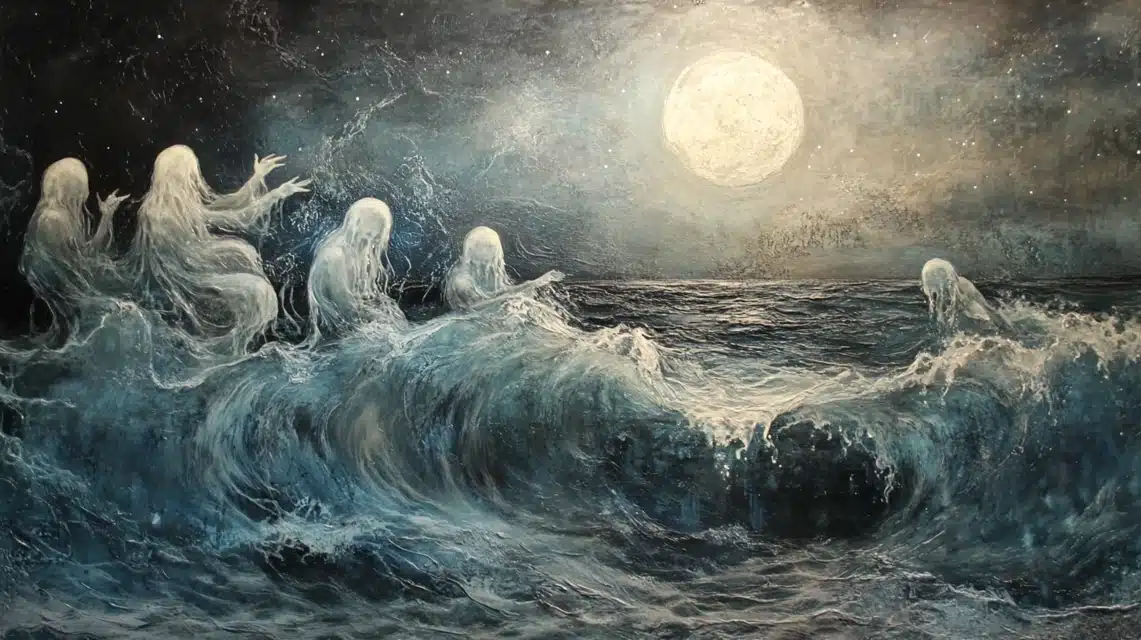
Silver moonlight dances across waves where merfolk once swam, now haunted by sea spirits.
Beneath starlit skies, ghostly forms weave between water and air, their essence as fluid as the waves.
Watch how phosphorescent plankton mirrors a spiritual glow, creating double magic on canvas.
Here, natural and supernatural blur together – is that sea spray or a spirit’s trailing form? Let viewers decide.
Complete Painting Process:
- Establish a dramatic seascape with moonlit water effects.
- Layer ghost forms using techniques mimicking water movement.
- Develop atmospheric effects blending natural and supernatural elements.
- Create luminous highlights suggesting both moonlight and spiritual energy.
- Blend edges between sky, sea, and spirit.
9. Luna’s Ghostly Gathering

Under Grandmother Moon’s watchful eye, spirits swirl in their midnight minuet.
Each brushstroke carries whispers of ancient stories as phantoms dance through lunar light.
See how clouds part, creating spotlight moments for our ethereal performers.
Light and shadow play hide-and-seek across the canvas, while spirits emerge from darkness only to fade again into night’s embrace.
Complete Painting Process:
- Create a dramatic night sky focusing on the moon’s luminous presence.
- Build ghost forms through the strategic removal of dark paint.
- Develop cloud structures framing supernatural elements.
- Layer translucent spirits suggest movement and flow.
- Polish atmospheric effects enhance a mystical mood.
10. Dia de los Muertos Spirit Dance
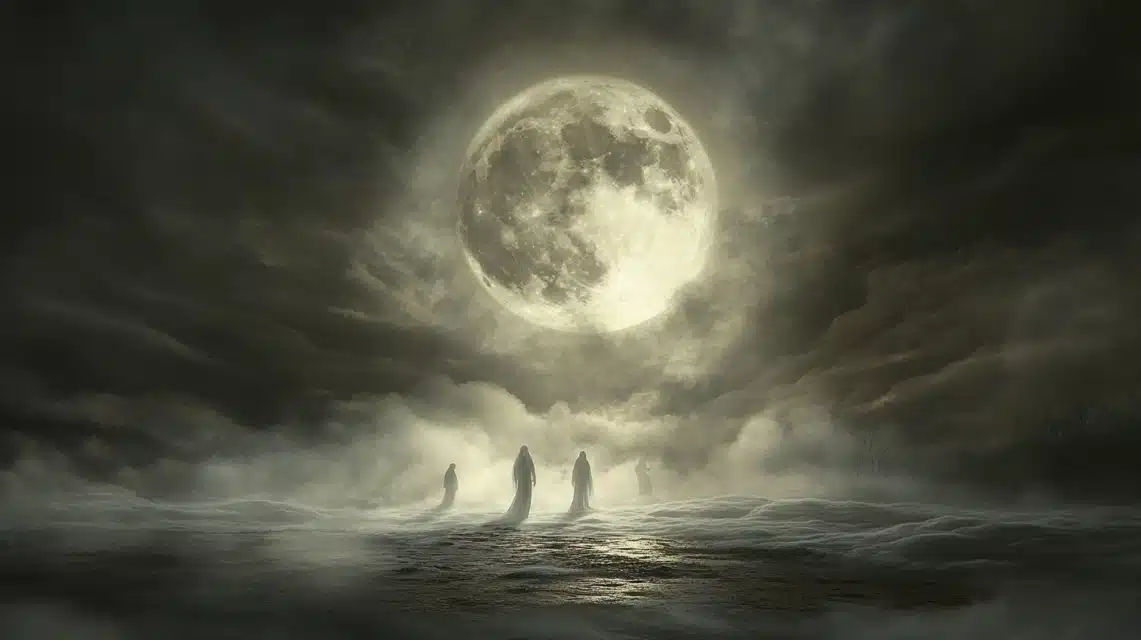
Unlike traditional ghost paintings, these spirits celebrate with explosive color and joyous movement.
Yesterday’s studio session taught me how cultural artistry transforms simple specters into decorated souls dancing between worlds.
Watch how marigold oranges weave through ethereal forms while sugar skull patterns emerge from translucent layers.
Each ghost carries its story through carefully chosen symbols—perhaps a baker’s spirit wrapped in painted bread motifs or a musician’s ghost trailing painted music notes.
Morning light catches the metallic details differently than evening shadows. Consider how gold leaf accents catch candlelight, turning simple spirits into luminous celebrations of life and death.
Complete Painting Process:
- Begin with spirit forms using a warm white base, suggesting transparency and movement
- Layer intricate pattern work drawing from traditional sugar skull designs
- Create dimensional effects through metallic paint and genuine gold leaf application
- Develop fabric-like flow incorporating traditional textile patterns
- Build final highlights emphasizing celebration rather than sorrow
11. Liquid Spirit Study
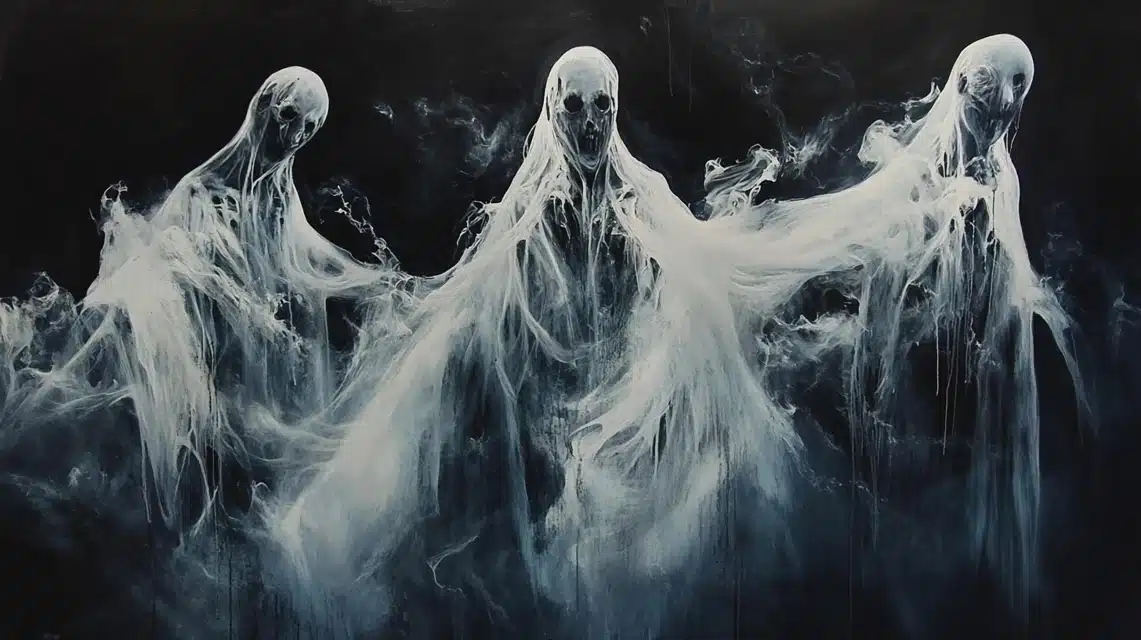
Defying traditional ghost forms, these spirits seem caught between states of matter.
Their essence flows like water yet holds shape like smoke, challenging viewers’ expectations.
Each figure begins solid at its core and then dissolves into atmospheric nothing.
Strategic drips become intentional design elements—some suggesting movement, others implying eternal tears.
Last night’s experiment proved how different paint consistencies create varying effects. Thick impasto holds to form, while liquid glazes suggest supernatural flow.
Complete Painting Process:
- Start with fluid abstract shapes establishing basic ghost forms
- Build dimensional effects through controlled paint viscosity
- Layer translucent colors, creating depth within each spirit
- Develop drip patterns using gravity as a creative partner
- Create final definition through strategic edge control
12. Friendly Phantom Fellowship

Breaking from spooky traditions, these spirits spread joy rather than fear.
Morning studio light revealed how subtle color variations transform intimidating apparitions into welcome friends.
Each ghost’s personality emerges through carefully crafted expressions – a slight curve here, a gentle tilt there.
Pastel backgrounds support rather than compete, allowing our spiritual friends to float in peaceful harmony.
Watch how different brush techniques affect the character – soft rounds for friendly curves and angle brushes for playful movement.
Complete Painting Process:
- Create a welcoming atmosphere using soft pastel background washes
- Develop distinct personalities through expression studies
- Build ghost forms using varying opacity levels
- Layer subtle colors suggesting individual character traits
- Polish final details emphasizing friendly interaction
13. Haunted House Transparency Tales

Morning light streams through my latest piece, revealing how layers build stories within stories.
Unlike solid figures, these spirits play with perception—appearing solid one moment and transparent the next.
Watch how architectural details peek through ethereal forms, creating a dialogue between structure and spirit.
Each ghost becomes part of the house’s history, their transparency revealing glimpses of wallpaper, window frames, and wooden beams beneath.
Strategic brushwork determines how much of the house shows through each spirit.
Some areas remain nearly opaque, suggesting stronger manifestations, while others barely disturb the view of the room behind them.
Consider how different times of day affect your ghost visibility.
Morning light might show subtle spirits, while evening shadows encourage their presence.
Complete Painting Process:
- Begin with detailed architectural rendering, establishing a solid house structure
- Create ghost mapping determining interaction points with house features
- Layer translucent spirit forms using carefully controlled opacity levels
- Develop intersection points where spirits pass through solid objects
- Build atmospheric effects enhancing supernatural presence
- Add final highlights suggesting movement between dimensions
- Create shadow effects reinforcing ghost placement within space
14. Retro Speech Bubble Spirits
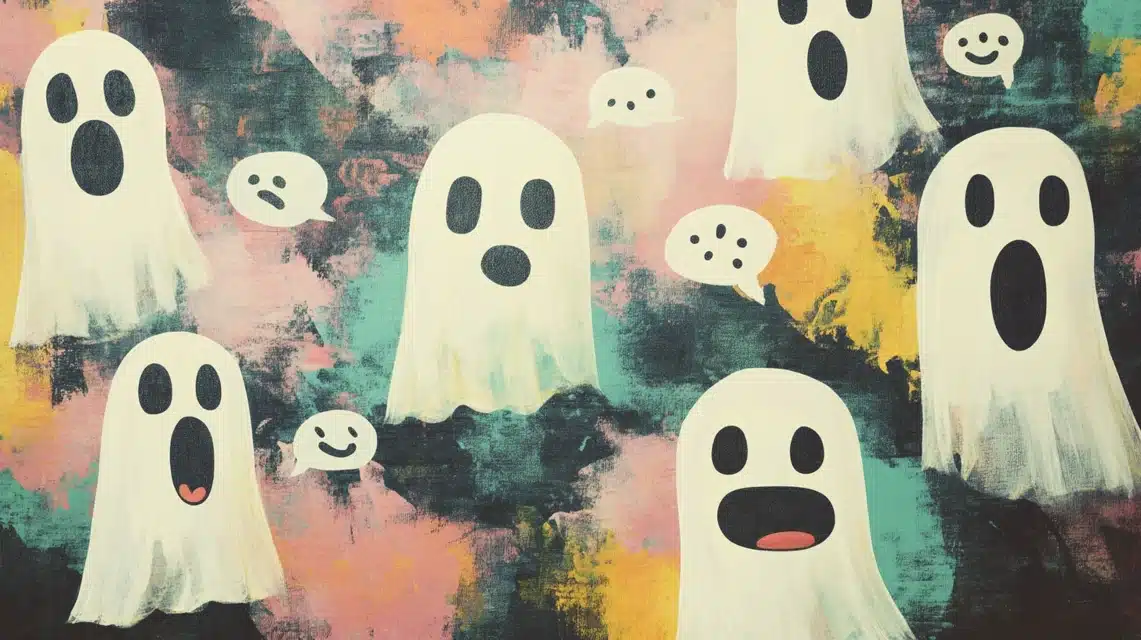
Remember those comic book ghosts that spoke in perfectly round bubbles? Let’s bring them back with modern flair.
Each phantom floats mid-conversation, its dialogue bubbles becoming part of the artistic composition.
Watch how vintage-inspired colors—mint greens, dusty pinks, and faded yellows—transform modern spirits into nostalgic treasures.
Strategic placement creates visual conversations across the canvas.
Some spirits whisper that their bubbles are small and intimate, while others proclaim boldly with exclamation points piercing their halos.
Complete Painting Process:
- Establish retro color palette drawing from vintage comic inspiration
- Design spirit characters with period-appropriate styling
- Create dynamic speech bubble placement enhancing composition
- Layer weathering effects suggesting age and character
- Build final highlights emphasizing the vintage charm
15. Pop Art Phantoms

Andy Warhol meets ectoplasm in this bold interpretation of spiritual art.
Unlike traditional ghost paintings, these spirits demand attention through vibrant colors and sharp contrasts.
Each ghost becomes a statement piece, repeated with varying color combinations, creating rhythm across the canvas.
Yesterday’s studio session proved how fluorescent touches transform simple spirits into electric apparitions.
Consider how different background colors affect each ghost’s presence. Some colors push spirits forward, while others create haunting depth.
Complete Painting Process:
- Design ghost motif suitable for repetition and color variation
- Create bold background blocks, establishing a pop art foundation
- Layer spirit forms using contrasting color combinations
- Develop clean edges essential for the pop art style
- Build final details emphasizing the graphic impact
Final Thoughts
Standing back from a finished ghost painting always reminds me how thin the veil between imagination and art truly is.
We’ve explored how simple paint transforms into spiritual storytelling through these fifteen techniques.
Remember that ghost painting isn’t just about technique – it’s about capturing moments between heartbeats.
Sometimes your most successful spirits emerge from “mistakes,” when paint flows unexpectedly or colors blend in surprising ways.
Technical Tips to Remember
- Keep your whites pure but varied – every ghost tells its own story through different opacity levels.
- Embrace happy accidents – sometimes running paint creates perfect spiritual movement.
- Allow backgrounds to participate in your ghost stories rather than simply supporting them.
- Document your process – each technique you discover builds your supernatural artistic vocabulary.
Frequently Asked Questions
What Kind of Paint Should I Use for Ghost Painting?
I recommend starting with acrylic whites mixed with glazing medium for ethereal effects.
This allows layering for transparency while maintaining control. Watercolors excel for misty effects, while oils provide rich depth for darker scenes.
Quality phosphorescent paint mixed with white creates perfect spiritual luminescence for glow effects.
How Do I Participate in The Ghost Painting Trend on TikTok?
Start with thrifted landscape paintings, which provide perfect backgrounds for ghostly additions.
Use titanium white mixed with a glazing medium for transparent effects.
Film your process, focusing on ghost formation through careful layering. Remember: less is often more when creating viral-worthy spirit art.
What Are Some Easy Ghost Painting Ideas for Beginners?
Begin with simple silhouettes against colorful backgrounds.
Practice basic ghost shapes using white paint on dark paper.
Try moonlit scenes where spirits need only suggest presence rather than show detail.
Start with small canvases, allowing quick completion while learning techniques.
How Can I Paint Ghosts on Thrifted Artwork?
First, test paint adhesion on a small corner. Then, create spirits using thin layers of white, allowing the original art to show through.
Consider placing the ghosts to complement the existing composition. Use quality paint to prevent cracking or peeling.
Document the original art before adding supernatural residents.
What Techniques Can I Make My Ghost Painting Unique?
Experiment with unusual color combinations beyond traditional whites.
Try different tools to create varied spirit textures. Incorporate mixed media elements like glow powder or metallic leaf.
Consider environmental interactions between spirits and surroundings. Develop a signature style through consistent technique modifications.






